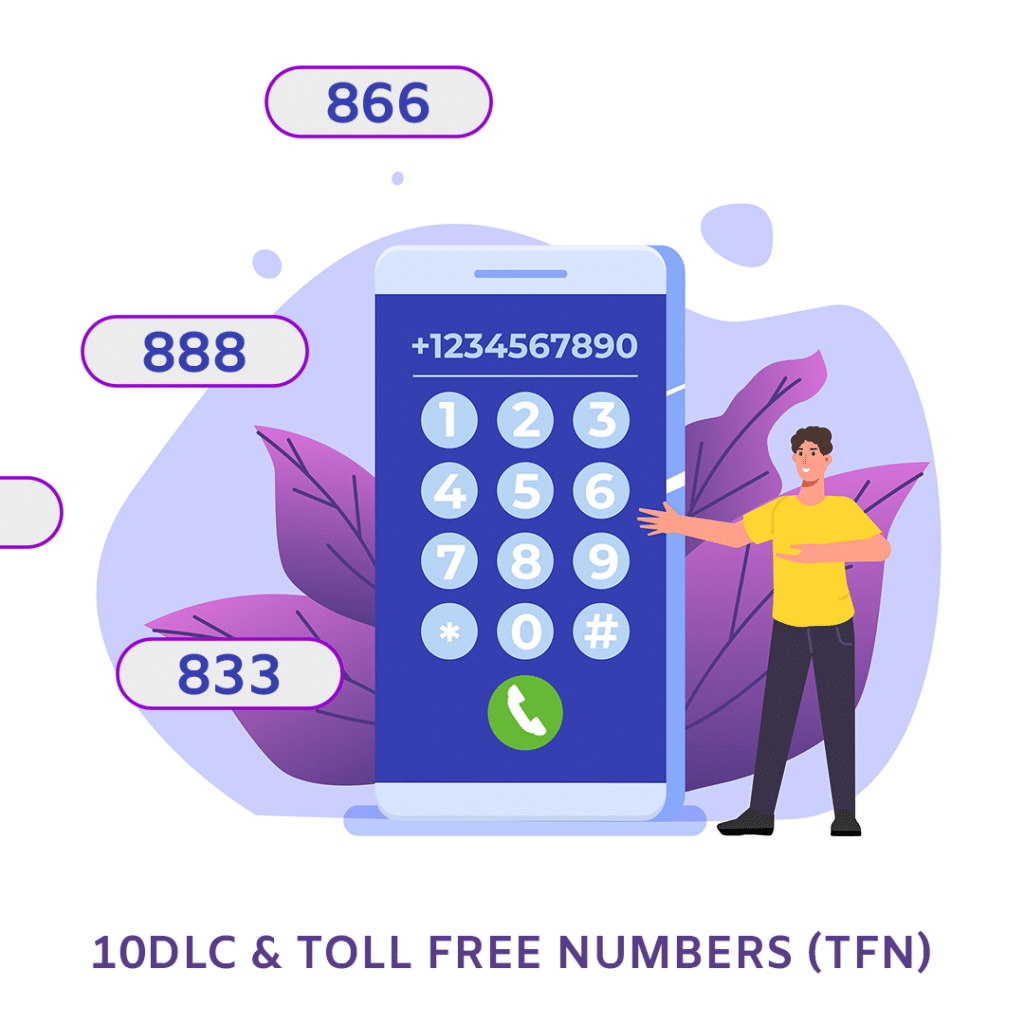📑 Table of Contents
- What Is a Toll-Free Phone Number?
- Can You Text a Toll-Free Number?
- What is the SMS Limit for Toll-Free Numbers?
- What’s Local vs. Toll-Free SMS?
- What is the Difference Between a Short Code and a Toll-Free Number?
- Benefits of Using SMS Toll-Free Numbers
- Tips for Effectively Using SMS Toll-Free Numbers
- The Impact of SMS Toll-free Numbers
- The Flipside of SMS Toll-Free Numbers
- How They Work and Who Reaps the Benefits?
In today’s fast-paced digital world, the way we communicate with businesses has evolved dramatically. Enter the SMS Toll-Free Number – a fascinating bridge between traditional toll-free calling and modern-day texting.
If you’ve ever wondered, “What is a SMS Toll-Free Number (TFN)?”, you’re in the right place. Let’s dive in!
What Is a Toll-Free Phone Number?
SMS toll-free numbers, or TFNs, are unique telephone numbers characterized by their “800”, “888”, “877”, “866”, “855”, “844” or “833” prefixes. Under the North American Numbering Plan (NANP), these numbers are assigned on a first-come, first-serve basis.
The fundamental defining feature of TFNs is that they allow individuals to send text messages to or receive text messages from a company without incurring any charges.
Unlike regular phone numbers, the cost of incoming calls or messages to these numbers is borne by the called party (typically a business) rather than the caller (the consumer).

Can You Text a Toll-Free Number?
Good question! Most of us associate toll-free numbers with voice calls, but here’s the twist: Yes, you can text them! This is where our main keyword, “SMS Toll-Free Number,” comes into play.
An SMS Toll-Free Number allows customers to send text messages to those same familiar 1-800 numbers. No need to remember a new number; just text the way you normally would.
What is the SMS Limit for Toll-Free Numbers?
Every good thing has its limits. For toll-free numbers, the SMS limit is typically set by the provider, but a common benchmark is around 160 characters, which is roughly one text message length.
If you exceed this, your message might be split into multiple texts or truncated. So, be concise!
What’s Local vs. Toll-Free SMS?
Now, you might be wondering about the difference between local and toll-free SMS. Local SMS is sent from a standard local number, just like the one your friend might text you from. It’s geographically specific.
On the other hand, a toll-free SMS is sent from a toll-free number (like 1-800). The major advantage? A more professional look and nationwide recognition.
Plus, businesses often find that customers trust toll-free numbers more, leading to better engagement.

What is the Difference Between a Short Code and a Toll-Free Number?
Ah, the million-dollar question! A shortcode is a 5 to 6-digit number used primarily for promotional campaigns. For instance, when you get a text saying, “Reply ‘YES’ to subscribe,” that’s often from a short code.
Curious to learn more about this? Check out our article: What is a short code?
In contrast, a toll-free number is longer, typically 10 digits, and is often associated with customer service or businesses. Both have their uses in the world of SMS marketing. For a deep dive into the realm of SMS promotion, don’t miss our SMS marketing guide.
Benefits of Using SMS Toll-Free Numbers
As we delve deeper into the world of toll-free texting, it’s essential to understand why businesses are jumping on board with this trend. Here’s why SMS toll-free numbers are gaining traction:
1. Enhanced Customer Experience: How many times have you wished you could simply send a quick text instead of waiting on hold for what feels like forever? With SMS toll-free numbers, customers can swiftly ask questions, get support, or provide feedback—all through a medium they use daily.
2. Cost-Effective: Contrary to popular belief, toll-free numbers are an economical solution for businesses. Given that the responses can be automated and the potential for increased customer engagement, the ROI is often well worth it.
3. Accessibility: Texting is not just for the younger generation anymore. With the growing ubiquity of smartphones, people of all ages prefer texting over calling. SMS toll-free numbers cater to this demographic shift, ensuring businesses remain accessible to everyone.
4. Increased Engagement Rates: Text messages have an impressive open rate of over 90%. When customers see a text from a familiar toll-free number—a number they trust—they are more likely to engage, leading to improved communication and better business outcomes.
5. Flexibility: Whether you’re running a promotional campaign, sending appointment reminders, or offering support, SMS toll-free numbers can handle a variety of tasks. They adapt to your business needs.
6. Security and Trust: Toll-free numbers have long been associated with established businesses. When customers see a toll-free number, there’s an inherent level of trust. Merging this trust with the convenience of SMS makes for a potent combination.

Tips for Effectively Using SMS Toll-Free Numbers
Now that we’ve explored the ‘what’ and ‘why’ of SMS toll-free numbers, let’s talk about the ‘how.’ Implementing toll-free texting is one thing, but doing it effectively is another. Here are some best practices to ensure you make the most out of this communication tool.
1. Keep Messages Clear and Concise: Remember, the limit for a single SMS is around 160 characters. While this may seem restrictive, it’s an opportunity to get to the point quickly. Avoid fluff and ensure every word serves a purpose.
2. Personalize When Possible: People love feeling special. Use the customer’s name or refer to past interactions to make messages feel personalized. This can greatly enhance engagement and foster a closer connection between the customer and your brand.
3. Set Clear Expectations: If you’re using automated responses, let your customers know. If they can expect a reply in a specific timeframe, communicate that. Setting clear expectations prevents frustration and builds trust.
4. Use a Consistent Tone: Whether you opt for a formal tone or a more laid-back approach, stay consistent. This helps reinforce your brand’s identity and ensures the customer always knows what to expect.
5. Incorporate CTAs (Call to Action): Drive engagement by incorporating clear CTAs in your messages. Whether it’s directing them to a link, asking for feedback, or encouraging them to make a purchase, a well-placed CTA can significantly boost conversion rates.
6. Respect Opt-Out Requests: Always provide an easy way for customers to opt out of receiving messages. Not only is this a legal requirement in many regions, but it also shows that you respect your customers’ choices and privacy.
7. Monitor and Adapt: Like any marketing strategy, it’s crucial to monitor the effectiveness of your SMS campaigns. Pay attention to metrics like response rate, conversion rate, and customer feedback. Use this data to continually refine your approach.

The Impact of SMS Toll-free Numbers
It’s hard to overstate the positive impact toll-free numbers can have on a business. The magic of SMS toll-free numbers lies in their capacity to foster open, cost-free communication between a company and its customers.
Such numbers are a boon for businesses of all sizes, but they particularly benefit those with customer service departments, creating an affordable, efficient channel for continuous customer contact.
The twin pillars of accessibility and affordability underpinning toll-free numbers make them indispensable for increasing customer engagement and ensuring businesses are always available whenever customers need assistance or information.
But the advantages of SMS toll-free numbers aren’t just operational—they’re also instrumental in marketing and branding efforts. These numbers, often memorable, enhance brand recognition and boost customer recall in promotional campaigns.
They can also be tailored to reflect a company’s brand image or marketing message through ‘vanity numbering’, providing an additional layer of brand personalization.
The Flipside of SMS Toll-Free Numbers
Despite its numerous benefits, the use of SMS toll-free numbers is not without potential pitfalls. High-volume businesses may experience bottlenecking due to the sheer number of incoming texts to a single number, which may result in slower response times and potentially unhappy customers.
Further, the cost of maintaining a TFN and paying for all incoming messages can quickly add up, especially for businesses that receive a high volume of SMS inquiries or feedback.
Another significant drawback hinges on the unwanted communication or spam that these numbers often attract. Due to the free nature of SMSing these numbers, businesses may be bombarded with irrelevant spam messages that consume valuable time and resources to filter out, potentially harming productivity.
Additionally, companies that operate internationally need to consider that toll-free numbers often do not operate outside of their domestic market. Hence, if a company has a vast international customer base, it might face challenges while using this system.

How They Work and Who Reaps the Benefits?
SMS toll-free numbers are a simple yet effective solution that provides an open line of communication between businesses and their customers.
When a customer sends a text message to a toll-free number, it is seamlessly routed through a telecommunications carrier directly to the business’s designated platform.
This can range from a customer relationship management (CRM) system to an email inbox, or even a mobile device.
Since the business bears the cost of this service, customers can effortlessly make inquiries, schedule appointments, or provide feedback without incurring any extra charges.
Wrapping Up!
Toll-free texting is more than just a novel way to reach customers; it’s a versatile tool that, when used correctly, can significantly enhance the customer experience. As with any tool, its effectiveness largely depends on how it’s used.
To stay ahead of the curve, always keep learning. Dive into topics that pique your curiosity. Educate yourself about the SMS marketing eco-system and understand what is SMS keyword, there’s a wealth of knowledge waiting for you.
Remember, in today’s digital landscape, staying connected isn’t just about reaching out, it’s about reaching out in the right way. Happy texting!
